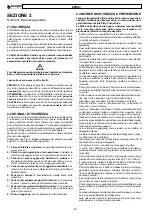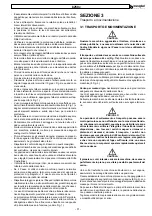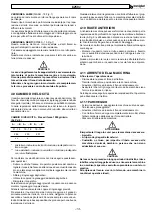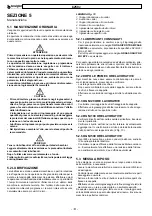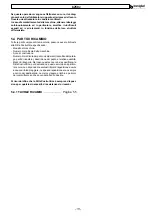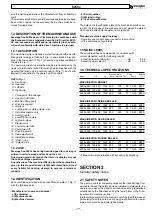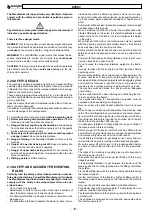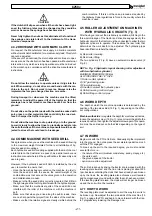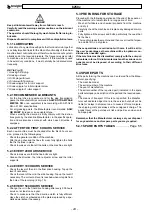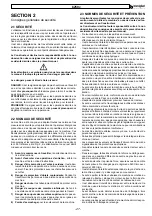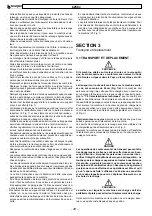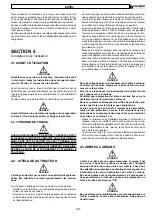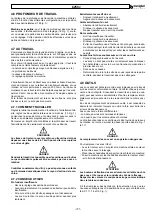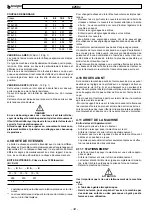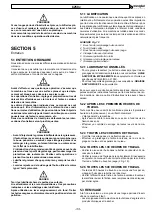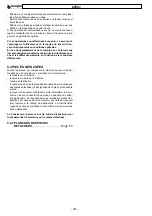
b250v
- 21 -
CAUTION
If the clutch still slips even when all the nuts have been tight-
ened, the friction plates must be changed as they could be
worn or because the springs have become slack.
Never fully tighten the nuts as this eliminates the function of
the springs and clutch itself, to the detriment of the trans-
mission components.
4.3.2 DRIVELINE WITH AUTOMATIC CLUTCH
On request, the Manufacturer can supply a driveline complete
with automatic clutch calibrated for a medium-duty load. This clutch
cannot be adjusted.
In the event of an overload, the clutch slips and continues to oper-
ate as soon as the obstruction has been passed, without external
intervention. Any clutch servicing operations must be carried out
in the workshop in compliance with the driveline manufacturer’s
instructions.
CAUTION
Do not allow the machine to operate unless it digs into the
soil. When working, do not drive around bends with the ma-
chine in the soil. Do not work in reverse. Always raise the
implement before you change direction or reverse.
During transport or whenever the machine must be lifted,
remember to adjust the power lift of the tractor so that the
steerage hoe is not raised more than about 40 cm from the
ground.
Do not drive on the public roads with the machine caked with
soil, grass or other materials that could dirty the road sur-
face or hamper the traffic in any way.
Do not allow the machine to drop violently on to the ground.
Lower it slowly to allow the tines to gradually penetrate into
the soil otherwise all the machine components would be sub-
jected to stress that could lead to breakages.
4.4 COMBI MACHINE WITH SEED DRILL
Take great care when you use the machine with a seed drill owing
to the maximum weight tolerated for the rear installation of hy-
draulic seed drill couplings.
Each hydraulic seed drill coupling supplied with the machine or at
a later date on the Customer’s request, has a serial number and
instruction manual where all the specifications for assembly and
use are given.
However, if the hydraulic seed drill hitch is installed by the end
user, remember to ensure that:
- Once the frame has been mounted on the machine, in order to
raise the seed drill with the seeds, the overall weight of the
combination must not exceed the value given in the operation
and maintenance manual.
- Make sure that the seed drill is correctly mounted, that it lifts in
the right way and that nothing interferes with the hydraulic pipes.
- Make sure that the mechanical parts of the seed drill do not
interfere with the roller of the machine or with the machine it-
self.
- Make sure that when you drive along the public roads, there
are no sharp parts that project from the sides of the machine.
- Make sure that the relative signs are clearly visible behind the
combi machine. If this is not the case, proceed as required by
the Highway Code regulations in force in the country where the
machine is used.
4.5 ROLLER ADJUSTMENT ON MACHINES
WITH HYDRAULIC CIRCUITS
(Fig. 8)
After having carried out the preliminary operations (hitching to the
three-point linkage of the tractor and driveline engagement), the
hydraulic circuit of the tractor must be connected to allow the two
hydraulic cylinders to operate. This enables the rear roller that
determines the work depth to be adjusted. The hydraulic pipes
have identification labels that depict:
A) Rear roller lowering.
B) Rear roller lifting.
The two cylinders (1 Fig. 8) have an automatic release valve (2
Fig. 8).
KEY to Fig. 8 (Hydraulic layout showing roller adjustment
with two hydraulic cylinders)
MAXIMUM PRESSURE 180 Bar
ALL PIPES ARE THE 1/4” SIZE
1) Roller control cylinders
2) 3/8” gas locking valve
3) Flow divider valve
4) Sheath to protect the hydraulic pipes
A) Roller lowering control oil pipe
B) Roller lifting control oil pipe
4.6 WORK DEPTH
The depth at which the machine operates is determined by the
position of the two side skids (15 Fig. 1), depending on the differ-
ent configurations.
Machine with skids
: to regulate the depth for machines with skids,
loosen the adjuster screw (16 Fig. 1), raise or lower the skid to the
required position, then tighten the adjuster screw again. This opera-
tion must be carried out on both skids depending on the type of
soil.
4.7 IN WORK
Begin work with the PTO at full rate. Gradually dig the implement
into the ground. Do not depress the accelerator pedal too much
with the PTO engaged.
To break up the soil to the required degree, you must consider
several factors, i.e.:
- the nature of the soil (medium consistency, sandy, clayey, etc.)
- the work depth
- the ground speed of the tractor
- optimum machine adjustment.
The soil is broken up by driving the tractor at a low speed, with the
levelling plate lowered and the tine rotor spinning at about 200
rpm. besides containing the clods that have already been broken
up by the tines, the levelling plate also achieves a well levelled
and homogeneous ground surface after the soil has been worked.
If the levelling plate is raised, the clods will not longer be broken
up and the soil will not be levelled.
4.7.1 HOW TO WORK
The levelling plate must be adjusted to suit the way the soil is to
be broken up. Now adjust the two side skids of the machine (15
Fig. 1), engage the PTO and begin to move forward with the trac-
tor, progressively lowering the steerage hoe.
Summary of Contents for B250V
Page 4: ... 4 b250v Fig 4 Fig 3 Fig 5 A B 1 3 MAX MIN 4 cm Fig 6 Fig 7 3 5 8 4 6 7 1 2 A ...
Page 5: ...b250v 5 Fig 9 Fig 8 1 2 3 4 5 Fig 10 A 6 7 1 2 3 4 A B Fig 7 a cm 40 ...
Page 61: ...b250v 61 Tav 6 0006615 5200451 0001020 0001177 5500367 ...
Page 68: ... 68 b250v Tav 13 ...
Page 69: ...b250v 69 Tav 14 0020675 E1200165 E1200165 8064873 0001020 0001019 8064565 0001042 ...
Page 70: ...b250v 70 Tav 15 Cod 8065842 ...
Page 71: ... 71 b250v Tav 16 Cod 8065846 ...


